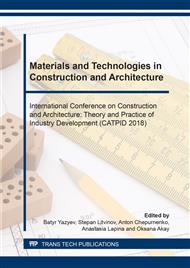[1]
A.M. Belostotsky, P.A. Akimov, I.N. Afanasyeva, T.B. Kaytukov, Contemporary problems of numerical modelling of unique structures and buildings, International Journal for Computational Civil and Structural Engineering. 2(13) (2017) 9-34.
DOI: 10.22337/2587-9618-2017-13-2-9-34
Google Scholar
[2]
A.M. Belostotskiy, P.A. Akimov, 25-th Anniversary of scientific research centre StaDyO, International Journal for Computational Civil and Structural Engineering. 1(12) (2016) 9-34.
Google Scholar
[3]
AFPS/AFTES. Guidelines on Earthquake Design and Protection of Underground Structures. Working Group of the French Association for Seismic Engineering (AFPS) and French Tunneling Association (AFTES). Version 1, (2001).
Google Scholar
[4]
J.N. Wang, Seismic Design of Tunnels: A Simple State-of-the-art Design Approach, New York, Parsons Brinckerhoff Quade and Douglas Inc., (1993).
Google Scholar
[5]
B. Jia, J. Li-ping, L. Yong-qiang, Seismic Analysis of Underground Structures Based on the Static Finite Element Method, The Electronic Journal of Geotechnical Engineering. 21(06) (2016) 2307-2315.
Google Scholar
[6]
FHWA. Technical Manual for Design and Construction of Road Tunnels – Civil Elements. U.S. Department of Transportation. Federal Highway Administration. Publication No. FHWA-NHI-10-034, (2009).
Google Scholar
[7]
ISO 23469. Bases for Design of Structures – Seismic Actions for Designing Geotechnical Works. ISO International Standard. ISO TC 98/SC3/WG10, (2005).
Google Scholar
[8]
H. Huo, A. Bodet, G. Fernandez, J. Ramirez, Load Transfer Mechanisms between Underground Structure and Surrounding Ground: Evaluation of the Failure of the Daikai Station, J. Geotech Geoenviron. 131(12) (2015) 1522-1533.
DOI: 10.1061/(asce)1090-0241(2005)131:12(1522)
Google Scholar
[9]
M. Ghergu, I.R. Ionescum, Structure – Soil – Structure Coupling in Seismic Excitation and City Effect,, Int. J. Eng. Sci. 47 (2009) 347-354.
Google Scholar
[10]
Y. Kawamata, M. Nakayama, I. Towhata, Dynamic behaviors of underground structures in E-Defense shaking experiments, Soil Dynamics and Earthquake Engineering. 82 (2016) 24-39.
DOI: 10.1016/j.soildyn.2015.11.008
Google Scholar
[11]
H.-F. Wang, M.-L. Lou, R.-L. Zhang, Influence of presence of adjacent surface structure on seismic response of underground structure, Soil Dynamics and Earthquake Engineering. 100 (2017) 131-143.
DOI: 10.1016/j.soildyn.2017.05.031
Google Scholar
[12]
Y.M.A. Hashasha, J.J. Hooka, B. Schmidt, J.I-C. Yaoa, Seismic Design and Analysis of Underground Structures, Tunnelling and Underground Space Technology. 16 (2001) 247-293.
DOI: 10.1016/s0886-7798(01)00051-7
Google Scholar
[13]
M. Zeghal, A.W. Elgamal, Analysis of Site Liquefaction Using Earthquake Records, J. Geotech. Eng. ASCE 120(6) (1994) 996-1017.
DOI: 10.1061/(asce)0733-9410(1994)120:6(996)
Google Scholar
[14]
M.J.N. Priestley Myths and Fallacies in Earthquake Engineering – Conflict between Design and Reality, Bull. Natl. Soc. Earthq. Eng. NZSEE 26(3) (1993) 329-341.
Google Scholar
[15]
E. Debiasi, A. Gajo, D. Zonta, On the seismic response of shallow-buried rectangular structures, Tunnelling and Underground Space Technology. 38 (2013) 99-113.
DOI: 10.1016/j.tust.2013.04.011
Google Scholar
[16]
Y. Zou, H. Liu, L. Jing, J. Cui, A pseudo-static method for seismic responses of underground frame structures subjected to increasing excitations, Tunnelling and Underground Space Technology. 65 (2017) 106-120.
DOI: 10.1016/j.tust.2017.02.006
Google Scholar
[17]
S. Fabozzi, V. Licata, S. Autuori, E. Bilotta, G. Russo, F. Silvestri, Prediction of the seismic behavior of an underground railway station and a tunnel in Napoli (Italy), Underground Space. 2(2) (2017) 88-105.
DOI: 10.1016/j.undsp.2017.03.005
Google Scholar
[18]
H.-F. Wang, M.-L. Lou, X. Chen, Y.-M. Zhai, Structure – soil – structure interaction between underground structure and ground structure, Soil Dynamics and Earthquake Engineering. 54 (2013) 31-38.
DOI: 10.1016/j.soildyn.2013.07.015
Google Scholar
[19]
S. Wang, Evaluation of underground pipe-structure interface for surface impact load, Nuclear Engineering and Design. 317 (2017) 59-68.
DOI: 10.1016/j.nucengdes.2017.03.021
Google Scholar
[20]
M.H. Baziar, M.R. Moghadam, D.-S. Kim, Y.W. Choo Effect of underground tunnel on the ground surface acceleration, Tunnelling and Underground Space Technology. 44 (2014) 10-22.
DOI: 10.1016/j.tust.2014.07.004
Google Scholar
[21]
J.F. Semblat, M. Kham, P.Y. Bard, Seismic-Wave Propagation in Alluvial Basins and Influence of Site-City Interaction, Bull. Seismol. Soc. Am. 98(6) (2008) 2665-2678.
DOI: 10.1785/0120080093
Google Scholar
[22]
A. Romero, P. Galvin, J. Antonio, J. Dominguez, A. Tadeu, Modelling of acoustic and elastic wave propagation from underground structures using a 2.5D BEM-FEM approach, Engineering Analysis with Boundary Elements. 76 (2017) 26-39.
DOI: 10.1016/j.enganabound.2016.12.008
Google Scholar
[23]
X. Wang, M. Cai, Numerical modeling of seismic wave propagation and ground motion in underground mines, Tunnelling and Underground Space Technology. 68 (2017) 211-230.
DOI: 10.1016/j.tust.2017.05.019
Google Scholar
[24]
A.M. Belostotsky, P.A. Akimov, D.S. Dmitriyev, About contemporary approaches to reduction of computational dimension of problems of structural analysis within finite element method, International Journal for Computational Civil and Structural Engineering. 3(13) (2017).
DOI: 10.22337/1524-5845-2017-13-3-19-33
Google Scholar
[25]
E. Sandoval, A. Bobet, Effect of frequency and flexibility ratio on the seismic response of deep tunnels, Underground Space. 2(2) 2017 125-133.
DOI: 10.1016/j.undsp.2017.04.003
Google Scholar
[26]
R. Fuentes, Internal forces of underground structures from observed displacements, Tunnelling and Underground Space Technology. 49 (2015) 50-66.
DOI: 10.1016/j.tust.2015.03.002
Google Scholar
[27]
G.M. Calvi, T.J. Sullivan, A Model Code for Displacement-Based Seismic Design of Structures, Pavia, IUSS Press, (2009).
Google Scholar
[28]
H. Sedarat, A. Kozak, Y.M.A. Hashash, A. Shamsabadi, A. Krimotat, Contact interface in seismic analysis of circular tunnels, Tunn. Undergr. Space Technol. 24(4) (2009) 482-490.
DOI: 10.1016/j.tust.2008.11.002
Google Scholar
[29]
A. Tateishi, A study on seismic analysis methods in the cross section of underground structures using static finite element method, Structural Engineering / Earthquake Engineering, JSCE. 22(1) (2005) 41-53.
DOI: 10.2208/jsceseee.22.41s
Google Scholar


